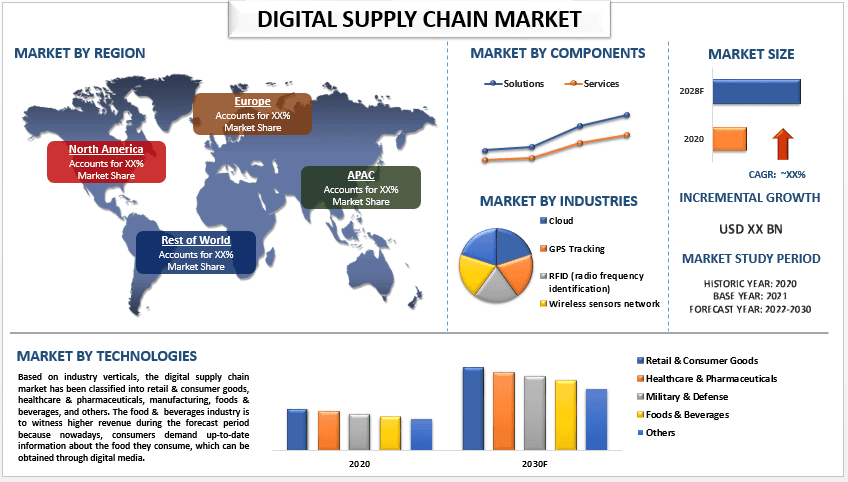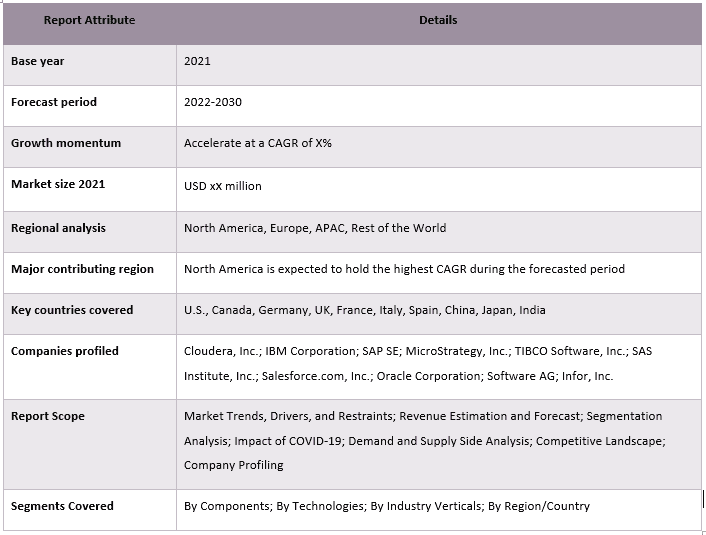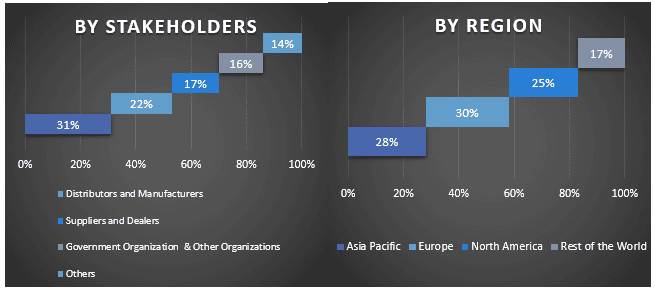- Trang chủ
- Về chúng tôi
- Ngành
- Dịch vụ
- Đọc
- Liên hệ với chúng tôi
Thị trường Chuỗi Cung ứng Kỹ thuật số: Phân tích Hiện tại và Dự báo (2022-2028)
Nhấn mạnh vào Thành phần (Giải pháp và Dịch vụ); Công nghệ (IoT, Cloud, GPS Tracking, RFID (nhận dạng tần số vô tuyến), Mạng lưới cảm biến không dây và các công nghệ khác); Các ngành dọc (Bán lẻ & Hàng tiêu dùng, Chăm sóc sức khỏe & Dược phẩm, Sản xuất, Thực phẩm & Đồ uống, Các ngành khác); và Khu vực/Quốc gia

Thị trường Chuỗi cung ứng kỹ thuật số được định giá x triệu USD vào năm 2021 & dự kiến sẽ tăng trưởng với tốc độ CAGR là x% từ năm 2022-2030. Nhờ sự tiến bộ ngày càng tăng trong các công nghệ như IoT, dịch vụ đám mây, GPS, v.v. Một chuỗi cung ứng sử dụng các công nghệ kỹ thuật số và phân tích dữ liệu để giúp đưa ra quyết định, cải thiện hiệu suất và ứng phó nhanh chóng với các điều kiện thay đổi được gọi là chuỗi cung ứng kỹ thuật số. Các chuỗi cung ứng được vi tính hóa sử dụng thông tin được cung cấp bởi từng bước của mạng lưới hàng tồn kho để lập kế hoạch hiệu quả và đưa ra các phản ứng năng động khi có sự chậm trễ bất ngờ. Các yếu tố như tăng cường cá nhân hóa, tính linh hoạt cao hơn và cải thiện lập kế hoạch đã thúc đẩy nhu cầu trên thị trường này. Trong những năm gần đây, nhu cầu về chuỗi cung ứng kỹ thuật số đã tăng lên đáng kể vì chúng tạo điều kiện thuận lợi cho các giao dịch được sắp xếp hợp lý, chúng kết nối các chức năng sản xuất, phân phối và dịch vụ khách hàng khác nhau. Các công ty lớn trên thị trường cung cấp các ứng dụng phân tích dữ liệu và phân tích dự đoán dữ liệu lớn với các tính năng công nghệ tiên tiến.
Một số công ty lớn đang hoạt động trên thị trường bao gồm Cloudera, Inc.; IBM Corporation; SAP SE; MicroStrategy, Inc.; TIBCO Software, Inc.; SAS Institute, Inc.; Salesforce.com, Inc.; Oracle Corporation; Software AG; Infor, Inc.
Thông tin chi tiết được trình bày trong báo cáo
“Trong số các thành phần, phân khúc giải pháp sẽ chứng kiến CAGR cao hơn trong giai đoạn dự báo”
Dựa trên các thành phần, thị trường được chia thành các giải pháp và dịch vụ. Trong giai đoạn dự báo, khu vực dịch vụ dự kiến sẽ có tốc độ tăng trưởng cao nhất vì khả năng hiển thị sự kiện và chuỗi cung ứng hỗ trợ các doanh nghiệp xác định các khía cạnh quan trọng của toàn bộ chuỗi cung ứng và quản lý các sự kiện ở các bộ phận khác nhau. Trong vài năm qua, việc áp dụng các giải pháp quản lý chuỗi cung ứng đã tăng lên đáng kể, điều này dẫn đến việc áp dụng các dịch vụ liên quan đến quản lý chuỗi cung ứng trên các ngành dọc khác nhau
“Trong số các công nghệ, phân khúc thực phẩm & đồ uống sẽ chiếm một thị phần đáng kể trên thị trường vào năm 2021”
Trên cơ sở công nghệ, thị trường được phân loại thành IoT, Cloud, GPS Tracking, RFID (nhận dạng tần số vô tuyến. Trong số này, IoT sẽ chiếm một thị phần đáng kể trên thị trường vào năm 2020. Điều này chủ yếu là do những lợi thế mà IoT mang lại so với các đối tác của nó, chẳng hạn như tăng khả năng hiển thị, dịch vụ khách hàng tốt hơn và theo dõi hàng hóa theo thời gian thực.
“Bắc Mỹ sẽ chiếm một thị phần đáng kể trên thị trường”
Bắc Mỹ được dự đoán sẽ tăng trưởng với tốc độ CAGR cao nhất trong giai đoạn dự báo. Điều này chủ yếu là do trí tuệ nhân tạo (AI), Internet of Things (IoT), robot và tự động hóa, ô tô tự hành, thực tế tăng cường và thực tế ảo, bản sao kỹ thuật số và mạng 5G là những công nghệ mới nổi ở Bắc Mỹ đang thúc đẩy xu hướng này. Ngoài ra, các công ty lớn trên thị trường như IBM Corporation, SAP SE và Salesforce.com, Inc. tiếp tục đầu tư vào việc tổ chức các giải vô địch khác nhau cho những người đam mê Powersports. Ví dụ: IBM Corporation và CSCO đang nỗ lực rất nhiều để xây dựng chuỗi cung ứng kỹ thuật số thông minh hơn và có khả năng tăng đáng kể khả năng phục hồi và hiệu suất.
Phạm vi báo cáo thị trường chuỗi cung ứng kỹ thuật số

Lý do mua báo cáo này:
- Nghiên cứu bao gồm phân tích kích thước thị trường và dự báo được xác thực bởi các chuyên gia hàng đầu trong ngành được xác thực.
- Báo cáo trình bày một đánh giá nhanh về hiệu suất tổng thể của ngành trong nháy mắt.
- Báo cáo bao gồm một phân tích chuyên sâu về các đồng nghiệp nổi bật trong ngành, tập trung chủ yếu vào các số liệu tài chính kinh doanh chính, danh mục sản phẩm, chiến lược mở rộng và các phát triển gần đây.
- Kiểm tra chi tiết các yếu tố thúc đẩy, hạn chế, xu hướng chính và cơ hội thịnh hành trong ngành.
- Nghiên cứu bao gồm toàn diện thị trường trên các phân khúc khác nhau.
- Phân tích sâu cấp khu vực của ngành.
Tùy chọn tùy chỉnh:
Thị trường Chuỗi cung ứng kỹ thuật số toàn cầu có thể được tùy chỉnh thêm theo yêu cầu hoặc bất kỳ phân khúc thị trường nào khác. Bên cạnh đó, UMI hiểu rằng bạn có thể có nhu cầu kinh doanh riêng, vì vậy hãy thoải mái liên hệ với chúng tôi để nhận được báo cáo hoàn toàn phù hợp với yêu cầu của bạn.
Mục lục
Phương Pháp Nghiên Cứu cho Phân Tích Thị Trường Chuỗi Cung Ứng Kỹ Thuật Số (2022-2030)
Phân tích thị trường lịch sử, ước tính thị trường hiện tại và dự báo thị trường tương lai của thị trường chuỗi cung ứng kỹ thuật số toàn cầu là ba bước chính được thực hiện để tạo và phân tích việc áp dụng chuỗi cung ứng kỹ thuật số ở các khu vực lớn trên toàn cầu. Nghiên cứu thứ cấp toàn diện đã được thực hiện để thu thập các số liệu thị trường lịch sử và ước tính quy mô thị trường hiện tại. Thứ hai, để xác thực những thông tin chi tiết này, nhiều phát hiện và giả định đã được xem xét. Hơn nữa, các cuộc phỏng vấn sơ cấp toàn diện cũng đã được thực hiện với các chuyên gia trong ngành trên toàn bộ chuỗi giá trị của thị trường chuỗi cung ứng kỹ thuật số toàn cầu. Sau khi giả định và xác thực các số liệu thị trường thông qua các cuộc phỏng vấn sơ cấp, chúng tôi đã sử dụng phương pháp tiếp cận từ trên xuống/từ dưới lên để dự báo quy mô thị trường hoàn chỉnh. Sau đó, các phương pháp phân tích thị trường và tam giác dữ liệu đã được áp dụng để ước tính và phân tích quy mô thị trường của các phân khúc và phân khúc phụ của ngành liên quan đến. Phương pháp luận chi tiết được giải thích dưới đây:
Phân Tích Quy Mô Thị Trường Lịch Sử
Bước 1: Nghiên Cứu Sâu về Các Nguồn Thứ Cấp:
Nghiên cứu thứ cấp chi tiết đã được thực hiện để có được quy mô thị trường lịch sử của thị trường chuỗi cung ứng kỹ thuật số thông qua các nguồn nội bộ của công ty như báo cáo thường niên & báo cáo tài chính, thuyết trình hiệu suất, thông cáo báo chí, v.v., và các nguồn bên ngoài bao gồm tạp chí, tin tức & bài viết, ấn phẩm của chính phủ, ấn phẩm của đối thủ cạnh tranh, báo cáo ngành, cơ sở dữ liệu của bên thứ ba và các ấn phẩm đáng tin cậy khác.
Bước 2: Phân Khúc Thị Trường:
Sau khi có được quy mô thị trường lịch sử của thị trường chuỗi cung ứng kỹ thuật số, chúng tôi đã tiến hành phân tích thứ cấp chi tiết để thu thập thông tin chi tiết về thị trường lịch sử và chia sẻ cho các phân khúc & phân khúc phụ khác nhau cho các khu vực lớn. Các phân khúc chính được bao gồm trong báo cáo như các thành phần, công nghệ và ngành dọc. Hơn nữa, các phân tích cấp quốc gia đã được thực hiện để đánh giá việc áp dụng chung các mô hình thử nghiệm trong khu vực đó.
Bước 3: Phân Tích Yếu Tố:
Sau khi có được quy mô thị trường lịch sử của các phân khúc và phân khúc phụ khác nhau, chúng tôi đã tiến hành phân tích yếu tố chi tiết để ước tính quy mô thị trường hiện tại của thị trường chuỗi cung ứng kỹ thuật số. Hơn nữa, chúng tôi đã tiến hành phân tích yếu tố bằng cách sử dụng các biến phụ thuộc và độc lập như loại đường sắt và loại ứng dụng của thị trường chuỗi cung ứng kỹ thuật số. Một phân tích kỹ lưỡng đã được thực hiện về các kịch bản cung và cầu xem xét các quan hệ đối tác hàng đầu, sáp nhập và mua lại, mở rộng kinh doanh và ra mắt sản phẩm trong lĩnh vực thị trường chuỗi cung ứng kỹ thuật số trên toàn cầu.
Ước Tính & Dự Báo Quy Mô Thị Trường Hiện Tại
Định Cỡ Thị Trường Hiện Tại: Dựa trên những hiểu biết sâu sắc có thể hành động từ 3 bước trên, chúng tôi đã đi đến quy mô thị trường hiện tại, những người chơi chính trong thị trường chuỗi cung ứng kỹ thuật số toàn cầu và thị phần của các phân khúc. Tất cả các tỷ lệ phần trăm chia sẻ và phân tích thị trường cần thiết đã được xác định bằng cách sử dụng phương pháp thứ cấp được đề cập ở trên và đã được xác minh thông qua các cuộc phỏng vấn sơ cấp.
Ước Tính & Dự Báo: Để ước tính và dự báo thị trường, trọng số đã được gán cho các yếu tố khác nhau bao gồm các động lực & xu hướng, hạn chế và cơ hội có sẵn cho các bên liên quan. Sau khi phân tích các yếu tố này, các kỹ thuật dự báo có liên quan, tức là phương pháp tiếp cận từ trên xuống/từ dưới lên đã được áp dụng để đưa ra dự báo thị trường cho năm 2028 cho các phân khúc và phân khúc phụ khác nhau trên các thị trường lớn trên toàn cầu. Phương pháp nghiên cứu được áp dụng để ước tính quy mô thị trường bao gồm:
- Quy mô thị trường của ngành, về doanh thu (USD) và tỷ lệ chấp nhận của thị trường Chuỗi Cung Ứng Kỹ Thuật Số trên các thị trường lớn trong nước
- Tất cả các tỷ lệ phần trăm chia sẻ, phân chia và phân tích các phân khúc thị trường và phân khúc phụ
- Những người chơi chính trong thị trường chuỗi cung ứng kỹ thuật số toàn cầu về các sản phẩm được cung cấp. Ngoài ra, các chiến lược tăng trưởng được các người chơi này áp dụng để cạnh tranh trong thị trường đang phát triển nhanh chóng
Xác Thực Quy Mô và Thị Phần Thị Trường
Nghiên Cứu Sơ Cấp: Các cuộc phỏng vấn chuyên sâu đã được thực hiện với những Người có Ảnh hưởng Quan trọng (KOLs) bao gồm các Giám đốc Điều hành Cấp cao (CXO/VPs, Trưởng phòng Kinh doanh, Trưởng phòng Tiếp thị, Trưởng phòng Vận hành, Trưởng phòng Khu vực, Trưởng phòng Quốc gia, v.v.) trên khắp các khu vực lớn. Các phát hiện nghiên cứu sơ cấp sau đó đã được tóm tắt và phân tích thống kê đã được thực hiện để chứng minh giả thuyết đã nêu. Thông tin đầu vào từ nghiên cứu sơ cấp đã được hợp nhất với các phát hiện thứ cấp, do đó biến thông tin thành những hiểu biết sâu sắc có thể hành động.
Phân Chia Người Tham Gia Sơ Cấp ở Các Khu Vực Khác Nhau

Kỹ Thuật Thị Trường
Kỹ thuật tam giác dữ liệu đã được sử dụng để hoàn thành việc ước tính thị trường tổng thể và để đưa ra các số liệu thống kê chính xác cho từng phân khúc và phân khúc phụ của thị trường Chuỗi Cung Ứng Kỹ Thuật Số toàn cầu. Dữ liệu được chia thành một số phân khúc & phân khúc phụ sau khi nghiên cứu các thông số và xu hướng khác nhau trong các lĩnh vực thành phần, công nghệ và ngành dọc trong thị trường Chuỗi Cung Ứng Kỹ Thuật Số toàn cầu.
Mục tiêu chính của Nghiên cứu Thị Trường Chuỗi Cung Ứng Kỹ Thuật Số Toàn Cầu
Các xu hướng thị trường hiện tại & tương lai của thị trường Chuỗi Cung Ứng Kỹ Thuật Số toàn cầu đã được xác định trong nghiên cứu. Các nhà đầu tư có thể thu được những hiểu biết chiến lược để dựa trên sự thận trọng của họ cho các khoản đầu tư dựa trên phân tích định tính và định lượng được thực hiện trong nghiên cứu. Các xu hướng thị trường hiện tại và tương lai xác định mức độ hấp dẫn tổng thể của thị trường ở cấp khu vực, cung cấp một nền tảng cho người tham gia công nghiệp khai thác thị trường chưa được khai thác để hưởng lợi từ lợi thế của người đi đầu. Các mục tiêu định lượng khác của các nghiên cứu bao gồm:
- Phân tích quy mô thị trường hiện tại và dự báo của thị trường Chuỗi Cung Ứng Kỹ Thuật Số về giá trị (USD). Ngoài ra, phân tích quy mô thị trường hiện tại và dự báo của các phân khúc và phân khúc phụ khác nhau.
- Các phân khúc trong nghiên cứu bao gồm các lĩnh vực loại đường sắt và loại ứng dụng.
- Xác định và phân tích khuôn khổ pháp lý cho ngành Chuỗi Cung Ứng Kỹ Thuật Số.
- Phân tích chuỗi giá trị liên quan đến sự hiện diện của các trung gian khác nhau, cùng với việc phân tích hành vi của khách hàng và đối thủ cạnh tranh của ngành.
- Phân tích quy mô thị trường hiện tại và dự báo của thị trường Chuỗi Cung Ứng Kỹ Thuật Số cho khu vực lớn.
- Các quốc gia chính của các khu vực được nghiên cứu trong báo cáo bao gồm Châu Á Thái Bình Dương, Châu Âu, Bắc Mỹ và Phần còn lại của Thế giới
- Hồ sơ công ty của thị trường Chuỗi Cung Ứng Kỹ Thuật Số và các chiến lược tăng trưởng được các người chơi thị trường áp dụng để duy trì trong thị trường đang phát triển nhanh chóng.
- Phân tích sâu về ngành ở cấp khu vực
Liên quan Báo cáo
Khách hàng đã mua mặt hàng này cũng đã mua










